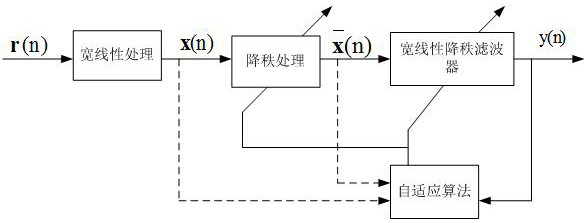A Space-Time Domain Adaptive Wide Linear Reduced Rank Beamforming Method
A space-time domain, wide linear technology, applied in the field of space-time domain adaptive wide linear reduced rank beamforming, can solve the problems of large output signal-to-interference noise ratio, algorithm performance degradation, large array degree of freedom, etc., and achieve output SINR increase. Large, reduced complexity, low complexity effects
- Summary
- Abstract
- Description
- Claims
- Application Information
AI Technical Summary
Problems solved by technology
Method used
Image
Examples
Embodiment 1
[0130] Embodiment 1: the DOA of the desired signal is (10°, 5°), and the signal-to-noise ratio (signal-to-noise ratio, SNR) is 20dB; the DOA of the 5 interfering signals are respectively (-40°, 10°), (-20°, 46°), (5°, 130°), (35°, 149°), (60°, 70°), the signal-to-interference ratio (SIR) is 10dB; all The center frequencies of the signals are 15.48MHz, 15.28MHz, 12.58MHz, 17.48MHz, 15.98MHz, and 16.98MHz; the step factor of the algorithm is u t =0.002, u w = 0.0002, for 500 independent experiments, we get Figure 4 The output SINR variation curves of the two algorithms are shown.
[0131] It can be seen from the simulation results that when the DOA of the desired signal does not change and the desired signal is not a frequency hopping signal, that is, when the space-time domain steering vector of the desired signal does not change, the results obtained by the two algorithms are basically consistent, which is consistent with the theoretical The derived results are the same. ...
Embodiment 2
[0132] Example 2: The initial DOA of the expected signal is (15°, 5°), which changes uniformly from (15°, 5°) to (25°, 20°) when the number of snapshots is 1000-1500 , the DOA kept unchanged after 1500 snapshots is (25°, 20°), SNR=20dB, and the center frequency is 15.48MHz; the DOA of the five interfering signals are (-40°, 10°), (-20° ,46°), (5°,130°), (35°,149°), (60°,70°), SIR=10dB, center frequencies are 15.28MHz, 12.58MHz, 17.48MHz, 15.98MHz, 16.98 MHz; the step factor u of the algorithm t =0.002, u w = 0.0002, for 1000 independent experiments, we get as Figure 5 shown in the output SINR variation curve and Image 6 The gain change curve shown.
[0133] It can be seen from the simulation diagram that the output SINR of the JIO-WLCMV SG algorithm will decrease when the DOA of the desired signal changes, and the gain in the direction of the desired signal cannot remain unchanged, while the algorithm proposed by the present invention will not change when the DOA of the ...
Embodiment 3
[0134] Embodiment 3: the DOA of the desired signal is (15°, 5°), SNR=20dB, when the number of snapshots n1500, the center frequency of the desired signal is 15.48MHz, when the number of snapshots is 1000≤n When ≤1500, every 100 snapshots the desired signal carrier frequency jumps once, and the center frequency jumps to 12.38MHz, 17.98MHz, 13.98MHz, 16.28MHz, 15.18MHz in turn; the DOA of the interference signal is (-40°, 10°) , SIR=10dB, the center frequency is 15.28MHz; the step factor u of the algorithm t =0.002, u w = 0.0002, for 500 independent experiments, we get Figure 7 The gain change curve shown.
[0135] It can be seen from the simulation results that when the desired signal is a frequency hopping signal, the JIO-WLCMV SG algorithm cannot guarantee that the gain in the direction of the desired signal remains 1, but the algorithm proposed by the present invention can keep the gain of the desired signal constant.
PUM
 Login to View More
Login to View More Abstract
Description
Claims
Application Information
 Login to View More
Login to View More - R&D
- Intellectual Property
- Life Sciences
- Materials
- Tech Scout
- Unparalleled Data Quality
- Higher Quality Content
- 60% Fewer Hallucinations
Browse by: Latest US Patents, China's latest patents, Technical Efficacy Thesaurus, Application Domain, Technology Topic, Popular Technical Reports.
© 2025 PatSnap. All rights reserved.Legal|Privacy policy|Modern Slavery Act Transparency Statement|Sitemap|About US| Contact US: help@patsnap.com



